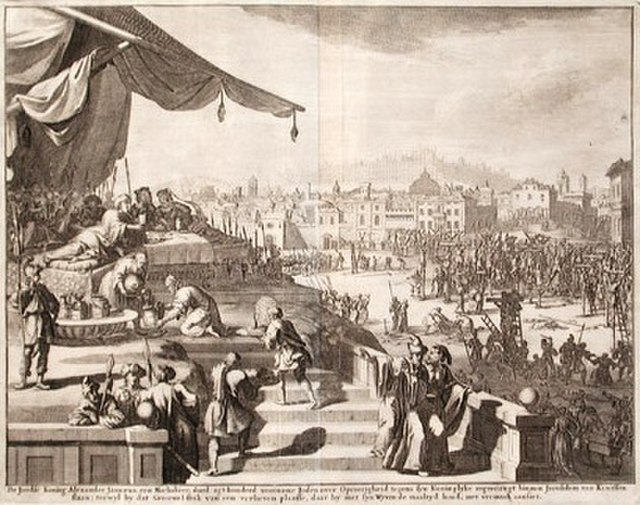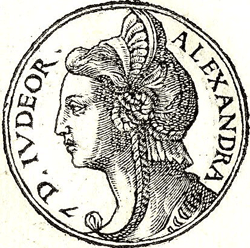by Kenneth C. Gutwein
Who was Salome Alexandra? Arguably, she was the most misunderstood queen in history. A warrior and successful administrator, much of her life is mysterious and unclear.
Josephus Flavius (37-c.100 CE), our main source for Salome, tells us nothing of her background. A Dead Sea Scroll fragment (4Q322) mentions her by her Hebrew name “Shlomzion” (Peace of Zion) without further details. Even the date of her birth is controversial. Kenneth Atkinson, a noted scholar who has written a great deal about Salome, places her birth at 141 BCE which would have made her 29 years old at the time of her marriage to Alexander Jannaeus. He would have been 14 or 16; even in an age of early marriages, this disparity would have been shocking.
Jannaeus’ father, John Hyrcanus (r.154-134 BCE) probably chose her for his son, as Atkinson says, “to groom him to be a functional member of the royal family”, as he was not expected to rule. Only after the unforeseen death of his older brothers, Aristobulus I (r.104-03 BCE) and Antigonus, did Alexander Jannaeus (103-76 BCE) inherit the throne.
Alexandra and the Pharisees
Although some scholars maintain that Alexandra came from a pious Jewish family of Pharisees, this is unlikely, as her husband slaughtered 800 Pharisees during his reign. Despite this, there can be no doubt that she favored the Pharisee sect. The Pharisees were a socio-religious movement in Judea during the time of the Second Temple (146BCE-70CE). After the destruction of the Temple in 70CE, their beliefs became the basis for Rabbinic Judaism. Primary among these beliefs was the acceptance of the Oral Law, or oral interpretation of the Torah, as equally important as the Written or Mosaic Law. This was a view that the more elite Sadducees or priestly class disputed, only accepting the Written Law. Josephus tells us that the Pharisees “ascribe everything to Fate or to God,” and “only the souls of good men pass into other bodies, while the souls of bad men [are] subjected to eternal punishment”. The Sadducees on the other hand, “deny Fate altogether,” as they also deny the permanence of the soul. Salome apparently favored the Pharisees even early on in her marriage, although her father-in-law John Hyrcanus I and husband Alexander Jannaeus favored the Sadducees.
Our sources, particularly Rabbinic ones, bestow high praise upon Salome. Atkinson says, “there are some passages in the Talmud that say that during her husband’s reign, she protected Pharisees and hid Pharisees from his wrath.” One of the leading Pharisees, Rabbi Shimon Ben Shetach (120-40 BCE) made frequent visits to the palace after her husband’s death, and apparently they became quite close. So close, in fact, that the Talmud claims that he was her brother although this is disputed. Nevertheless, after Jannaeus’ death, they were closely associated, and once she came to power, she supported Shimon’s Pharasaic reforms. These included revising the marriage law to be more favorable to women with a “ketubah” (formal marriage contract), as well as the reorganization of the Sanhedrin, which became a supreme court for the administration of religious matters and justice. The Pharisees now became the ruling class for all religious matters, with the appointment of her older son Hyrcanus II as high priest who was totally supportive of the Pharisees.
Warrior Queen
Another aspect on her life is her role as a warrior queen. Having endured her husband’s penchant for incessant warfare for 27 years, she was summoned to the site of Alexander Jannaeus’ last campaign against the Nabateans at Ragaba in 76 BCE. While there, Jannaeus whom we are told was “afflicted with a quartan ague (fever) …He died…after reigning 27 years.” Josephus tells us that on his deathbed, Jannaeus:
“…left his throne to his wife Alexandra, confident that the Jews would most readily submit to her, since by her freedom from any trace of his brutality, and constant opposition to his excesses, she had gained the goodwill of the people.”
Although Josephus was correct in the last part of the statement, he was quite mistaken if he thought she would meekly ascend to the throne. Josephus’ account has been disputed by Atkinson, who claims that Jannaeus was actually in Jerusalem when he died. Nevertheless, both ancient sources agree that Alexandra was with the troops at Ragaba with her general Diagos, leading the troops to victory. She also doubled the size of the army, added a large mercenary force, and fortified towns in the hinterland with forts and castles. Alexandra dispatched an army to Damascus on the grounds that Ptolemy was meddling there. Although that campaign was unsuccessful, it put him on notice that she was not to be trifled with. In fact, she kept the peace by skillful negotiations with Judea’s enemies and construction of strategic strongholds. Three of those, Alexandrium, Hyrcania and Macherus kept the trade routes to Judea open to commerce. She also kept the powerful Armenian King Tigranes at bay and expelled him from the region, a feat the later occupation by the Romans could not accomplish. So, besides making Judea strong, she also inspired a healthy respect in foreign rulers.
Dead Sea Scrolls
During her nine year reign (76-67 BCE), Salome Alexandra proved herself to be an outstanding administrator, bringing peace and prosperity to Judea. She completely reversed her late husband’s hostile policy towards the Pharisees and brought them into her government. Although Josephus displays his antipathy to female rulers by stating, “But while she ruled others, the Pharisees ruled her”.
She also promoted female education with Shimon Ben Shetach’s approval, and in another Dead Sea scroll (called Hosea Pesher A) the writer lauds an unprecedented period of prosperity that clearly took place during her reign. The Talmud preserves that acknowledgment by stating that during her rule, rain fell only on Sabbath nights, so that laborers would not lose pay if the rains came during the work week. In addition, the fertility of the soil was so great that grains of wheat grew as large as kidney beans, oats as large as olives, and lentils as large as gold coins.
A controversial fragment from the Dead Sea Scrolls of the now-lost Book of Nahum casts aspersions on Salome Alexandra. It describes the wickedness of her husband Alexander Jannaeus’ reign as the “Lion of Wrath,” and then says that after his death a “harlot” ruled Jerusalem, which became a “bloody city”. Lawrence Schiffman, a noted Dead Sea Scrolls scholar believes that the “harlot” refers not to Salome but to the Pharisees, the hated enemies of the Qumran sect that penned the scroll. Perhaps the only blot that can be leveled against Salome Alexandra’s is her treatment of her sons. She seemed to be unable to quell the sibling rivalry between her sons Hyrcanus and Aristobulus for the succession. She appointed Hyrcanus High Priest and heir, which incited his younger brother Aristobulus to attack him in Jerusalem. They fought, and Hyrcanus abdicated after 3 months. Then 2 years later, he tried to retake the throne of his brother. To settle this dispute a third party was called in – the Romans. The Roman general and consul Pompey conquered Judea in 63 BC. This effectively ended the Hasmonean dynasty that had lasted for 100 years.
Salome Alexandra reigned for nine years. She died in 76 BCE. We do not know how she died, as Josephus only mentions that “the queen had fallen into a dangerous distemper” and was “sickened”. There can be no doubt, however, that she was an amazing woman for her time, or indeed any time. Having been placed into an arranged marriage with a husband many years her junior from a dysfunctional family, she overcame the stigma of his murderous reign to set her own course as a female ruler in a culture in which only males were considered competent to rule. Yet, her piety, shrewdness, and diplomacy earned Salome Alexandra the loyalty of her people, and that of the religious and secular classes alike. Little wonder she was styled “Shelomzion ha Malka” the Queen for the Peace of Zion: a title that she rightfully earned.












One comment
Keep in mind that Judea was under growing Roman domination. The Pharisees had no legitimacy as priests as they belonged to the wrong tribe. She apparently cut a seal with them to maintain power despite enmity between the parties. She also failed to improve the nation’s plight.
Our apologies, you must be logged in to post a comment.